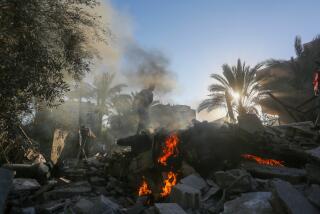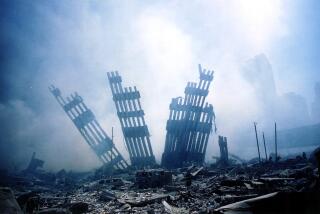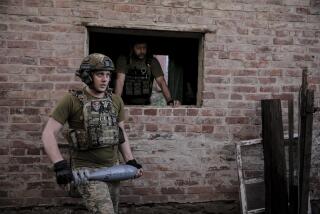The gulf gap
- Share via
Twenty years ago this week, despite fears of “another Vietnam,” the House and Senate voted to authorize the use of force against Iraqi troops occupying Kuwait.
After days of impassioned debate, the House supported President George H.W. Bush’s policy by a comfortable margin. The Senate’s 52-47 vote was the closest margin for war by a chamber of Congress in U.S. history.
The anniversary of the Persian Gulf War, a watershed event in modern American history, has gone almost entirely unnoticed. This oversight is perplexing given the presence of about 50,000 U.S. troops in Iraq today and the countless connections between the swift liberation of Kuwait in 1991 and the protracted occupation of Iraq, now winding down after eight painful years.
The relationship between the two conflicts, however, is not as simple as it may appear.
Many, including some of the architects of the Iraq war, saw the 2003 invasion to overthrow Saddam Hussein as the long-overdue completion of a mission left unfinished in 1991. This interpretation not only overlooks the clearly stated goals of the Persian Gulf War but also the almost diametrically opposed principles underlying the two conflicts.
In 1991, the elder President Bush responded to the Iraqi invasion of Kuwait by saying simply, “This will not stand.” A large, powerful nation should not be allowed to resolve an international dispute by invading and occupying a weaker nation.
In the Iraq war, President George W. Bush said, in effect, that in certain circumstances, powerful nations can invade and occupy weaker nations. In effect, the United States was proposing to do to Iraq in 2003 what Iraq had done to Kuwait in 1990 — namely, attempt to resolve long-festering disputes by means of invasion, removal of the government and occupation.
But there are connections as well as distinctions between the Persian Gulf War and the conflicts that occupy us today.
U.S. ground troops left Iraq after the Persian Gulf War, but they remained in the region, most significantly in Saudi Arabia, home to the holiest sites in Islam. In 1998, when Al Qaeda leader Osama bin Laden directed an attack on U.S. embassies in Tanzania and Kenya, he chose a symbolic date: Aug. 7, the day in 1990 when the first U.S. forces started flowing into Saudi Arabia in response to the Iraqi takeover of Kuwait.
The coalition’s swift victory in the Persian Gulf War, coming as it did in the final months of the Soviet Union’s existence, cemented a belief that no army could stand up to the modern U.S. war machine. It was that conclusion that drove U.S. adversaries to develop tactics that favored hit-and-run strikes over direct confrontation.
Al Qaeda put the concept of asymmetrical war into practice with a series of increasingly spectacular terrorist attacks. Iraq’s Hussein, facing an imminent U.S.-led invasion, made plans for a protracted guerrilla war — one that, as it turned out, far outlasted his regime.
The U.S. intelligence community made three key misjudgments concerning the Persian Gulf War that would have long-term consequences.
First, until the very last moment, when the meaning of Iraqi troop movements became unmistakable, the CIA assumed that Iraqi threats against Kuwait were merely an intimidation campaign. Hussein’s forces, the CIA judged, were too exhausted from their decade-long war with Iran to launch another major conflict.
Second, the CIA warned members of Congress that the U.S.-led coalition could suffer heavy casualties in the fight to liberate Kuwait. When coalition casualties turned out to be mercifully low, some Democrats who had opposed the authorization complained that the CIA had fed them faulty, worst-case analysis.
Third, after the war, U.S. intelligence was stunned to learn that Iraq was much further along in developing nuclear weapons than estimated.
A dozen years later, as Congress debated another war against Iraq, U.S. intelligence essentially reversed those three estimates. It portrayed Iraq as a determined aggressor, predicted light casualties for U.S. forces and warned that Iraq had chemical and biological weapons and was reconstituting its nuclear weapons program.
In the fall of 2002, memory of the swift and popular victory in 1991 contributed to the overwhelming vote in Congress authorizing the use of force against Iraq.
As it turned out, of course, Iraq had no weapons of mass destruction. What it did have was an almost unlimited supply of conventional explosives, the building blocks of deadly roadside bombs. The frightening casualties predicted but not realized in the Persian Gulf War were exceeded in the Iraq war.
The Persian Gulf War liberated a small country from a brutal occupation. It restored America’s confidence in its military. And it upheld the fundamental principle that international aggression should meet with international opposition. But its longer-term legacy is deeply mixed.
It spawned a library of histories and memoirs published in the aftermath of the coalition’s victory. Two decades later, with U.S. forces still deeply embedded in Iraq, and with Islamic enemies determined to force the United States out of the Middle East, the Persian Gulf War is ripe for another look.
John Diamond is the author of “The CIA and the Culture of Failure: U.S. Intelligence From the End of the Cold War to the Invasion of Iraq.”
More to Read
A cure for the common opinion
Get thought-provoking perspectives with our weekly newsletter.
You may occasionally receive promotional content from the Los Angeles Times.










